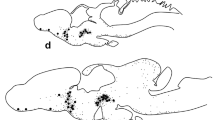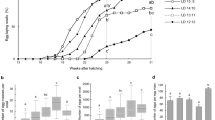Summary
-
1.
In late summer and autum many temperate-zone birds pass through a refractory period during which testicular growth cannot be induced experimentally with long daily photoperiods. This phenomenon is caused naturally by the long days of spring and early summer. It involves a decrease in release of gonadotropins by the adenohypophysis. Since previous investigations indicate that the release of gonadotropin is mediated by the hypothalamic neurosecretory system, a study of neurosecretory activity during refractoriness is basic for the understanding of this phenomenon.
-
2.
Preliminary morphological studies on refractory birds revealed lateral divisions of neurosecretory cells lying between the supraoptic and paraventricular nuclei regions previously described (Oksche et al. 1959). Neurosecretory axons from these divisions join the tracts which pass to the median eminence.
-
3.
Birds maintained in outdoor aviaries and killed from May through September showed a pronounced increase of neurosecretory material in the median eminence in late June, when testes regressed. This was accompanied by increases in neurosecretory material in the tracts and lateral division of neurosecretory cells described above, with reduction in sizes of cells and cell nuclei. The amount of neurosecretory material in the supraoptic nucleus was variable, but showed some increase, and the cells, again, decreased strikingly in size.
-
4.
A series of birds was killed in the field from September through December. In the first part of this period there were considerable quantities of neurosecretory material in the median eminence. A pronounced reduction occurred in mid-October shortly before the earliest date at which positive testicular responses to long daily photoperiods have been obtained experimentally. The pathways from the lateral divisions of neurosecretory cells contained material initially (September) and at the end of the period (December) but were empty in late October and early November. The lateral divisions of neurosecretory cells contained minimal quantities of neurosecretory material at this time; the cells and nuclei appeared larger. Cells of the nucleus supraopticus contained variable amounts of neurosecretory material, but cells and nuclei reached a maximum in size, and presumably in activity, in late October and early November.
-
5.
In studies of photoperiodic testicular response, birds were tested with 15-hour and 20-hour photoperiods at intervals from September through May. A positive response to long daily photoperiods first appeared in late October and early November. In adult birds the rate of response to 15-hour photoperiods was initially low, but increased significantly over November–December. The response of first-year birds (i.e. birds hatched during the previous summer) to 15-hour photoperiods proved difficult to interpret. On 20-hour photoperiods, however, the testicular growth rate was initially low, and increased significantly over November, December and January to an apparent maximum for this day length.
-
6.
It is suggested that during refractoriness a factor required for the synthesis and/or release of gonadotropins cannot be transferred from the axons of the median eminence via the portal capillaries to the adenohypophysis in sufficient quantities to cause a testicular response. The inhibition at the level of the median eminence expresses itself histologically as an accumulation of neurosecretory material in the hypothalamus and a reduction in the amount of cytoplasm and the size of cell nuclei in neurosecretory regions. This inhibition sinks below an effective level for complete refractoriness in middle and late October, while days are still long enough to cause some activity of the neurosecretory system. This minor resumption of activity in autumn is probably associated with the autumnal gonadal recrudescence observed in some species. The reduced rates of testicular response obtained experimentally in November–December are attributed to persistent low-level activity of the inhibitory process. The reduced activity of the neurosecretory system after late autumn in wild birds is apparently attributable to the essentially nonstimulating effect of the shorter day lengths of this season.
Similar content being viewed by others
References
Assenmacher, I.: Recherches sur le contrôle hypothalamique de la fonction gonadotrope préhypophysaire chez le canard. Arch. Anat. micr. Morph. exp. 47, 447–572 (1958).
Benoit, J., et I. Assenmacher: Action des facteurs externes et plus particulièrement du facteur lumineux sur l'activité sexuelle des oiseaux. II Réun. des Endocrinologistes de Langue Française, p. 33–80, 1953.
—: Le controle hypothalamique de l'activité préhypophysaire gonadotrope. J. Physiol. (Paris) 47, 427–567 (1955).
—: The control by visible radiations of the gonadotropic activity of the duck hypophysis. Recent Progr. Hormone Res. 15, 143–164 (1959).
— et F. X. Walter: Réponses du mécanisme gonadostimulant à l'éclairement artificiel et de la préhypophyse aux castrations bilatérale et unilatérale, chez le canard domestique mâle, au cours de la période de régression testiculaire saisonnière. C. R. Soc. Biol. (Paris) 144, 573–577 (1950).
—, F. X. Walter et I. Assenmacher: Sensibilité testiculaire aux hormones gonadotropes hypophysaires chez le canard domestique, au cours de la période de régression testiculaire saisonière. C. R. Soc. Biol. (Paris) 144, 1400–1403 (1950).
Bissonnette, T. H.: Studies on the sexual cycle in birds. I. Sexual maturity, its modification and possible control in the European starling (Sturnus vulgaris). Amer. J. Anat. 45, 289–305 (1930a).
Bihronnette, T. H.: Studies on the sexual cycle in birds. III. The normal regressive changes in the testis of the European starling (Sturnus vulgaris) from May to November. Amer. J. Anat. 46, 477–497 (1930b).
Blanchard, B. D.: The white-crowned sparrows (Zonotrichia leucophrys) of the Pacific seaboard: environment and annual cycle. Univ. Calif. Publ. Zool. 46, 1–178 (1941).
—, and M. M. Erickson: The cycle in the Gambel sparrow. Univ. Calif. Publ. Zool. 47, 255–318 (1949).
Clark, L. B., S. L. Leonard and G. Bump: Light and the sexual cycle of game birds. Science 85, 339–340 (1937).
Farner, D. S.: Photoperiodism in animals with special reference to avian testicular cycles. In: Photobiology. Oregon State College Biology Colloquium, p. 17–29, 1958.
- Photoperiodic control of annual gonadal cycles in birds. In: Photoperiodism and related phenomena in plants and animals. Amer. Ass. Adv. Sci. Publ. 55, 717–750 (1959).
—: Comparative physiology: Photoperiodicity. Ann. Rev. Physiol. 23, 71–96 (1961).
—, and L. R. Mewaldt: The natural termination of the refractory period in the white-crowned sparrow. Condor 57, 112–116 (1955).
—, A. Oksche, H. Kobayashi and D. F. Laws: Hypothalamic neurosecretion in the photo-periodic testicular response in birds. Anat. Rec. 137, 354 (1960).
—, and A. C. Wilson: A quantitative examination of testicular growth in the white-crowned sparrow. Biol. Bull. 113, 254–267 (1957).
Grignon, G.: Dévelopement du complexe hypothalamo-hypophysaire chez l'embryon de poulet. Nancy: Société d'impressions typographiques 1956.
Hertl, M.: Das Verhalten einiger Hypothalamuskerne der weißen Maus während verschiedener Entwicklungs- und Funktionsphasen des weiblichen Genitalapparates. Z. Zellforsch. 42, 481–507 (1955).
Kobayashi, H., and D. S. Farner: The effect of photoperiodic stimulation on phosphatase activity in the hypothalamo-hypophysial system of the white-crowned sparrow, Zonotrichia leucophrys gambelii. Z. Zellforsch. 53, 1–24 (1960).
Laws, D. F.: Hypothalamic neurosecretion in the refractory and postrefractory periods and its relation to the rate of photoperiodically induced testicular growth in Zonotrichia leucophrys gambelii. Doctoral thesis. Washington State University 1960.
Legait, H.: Contribution à l'étude morphologique et expérimentale du système hypothalamoneurohypophysaire de la Poule Rhode-Island. Thèse, Louvain. Nancy: S. I. T. 1959.
Lofts, B., and A. J. Marshall: An investigation of the refractory period of reproduction in male birds. J. Endocr. 17, 91–98 (1958).
Marshall, A. J.: The interstitial cycle in relation to autumn and winter sexual behaviour in birds. Proc. Zool. Soc. Lond. 121, 727–740 (1952).
Miller, A. H.: Potentiality for testicular recrudescence during the annual refractory period of the golden-crowned sparrow. Science 109, 546 (1949).
Mood, A. McF.: Introduction to the theory of statistics. London and New York: McGraw Hill 1950.
Oksche, A.: Optico-vegetative regulatory mechanisms of the diencephalon. Paper at the VIIth International Congress of Anatomists, New York 1960. Anat. Anz. 108, 320–329, (1960).
- Die Beteiligung der Neuroglia an sekretorischen Leistungen und Stoffwechselvorgängen des Zentralnervensystems unter besonderer Berücksichtigung des Subkommissuralorgans. Habil.-Diss. Medizinische Fakultät der Universität Marburg a. d. Lahn 1960 (in press).
—, D. F. Laws, F. I. Kamemoto and D. S. Farner: The hypothalamo-hypophysial neurosecretory system of the white-crowned sparrow, Zonotrichia leucophrys gambelii. Z. Zellforsch. 51, 1–42 (1959).
Riley, G. M.: Light regulation of sexual activity in the male sparrow (Passer domesticus). Proc. Soc. exp. Biol. (N.Y.) 34, 331–332 (1936).
Romeis, B.: Mikroskopische Technik. München: R. Oldenburg 1948.
Schildmacher, H.: Über die künstliche Aktivierung der Hoden einiger Vogelarten im Herbst durch Belichtung und Vorderlappenhormone. Biol. Zbl. 59, 653–657 (1939).
Shank, M.: The natural termination of the refractory period in the slate-colored junco and in the white-throated sparrow. Auk 76, 44–54 (1959).
Threadgold, L. T.: The annual gonad cycle of the male jackdaw, Corvus monedulus; quantitative aspects. Cellule 58, 45–54 (1956).
—: Testicular response of the house sparrow, Passer domesticus, to short photoperiods and low intensities. Physiol. Zool. 33, 190–205 (1960).
Vaugien, L.: Influence de l'obscuration temporaire sur la durée de la phase réfractaire du cycle sexuel du moineau domestique. Bull. biol. France Belg. 88, 294–309 (1954).
—: Sur les réactions testiculaires du jeune moineau domestique illuminé à diverses époques de la mauvaise saison. Bull. biol. France Belg. 89, 218–244 (1955).
—: Influence de la durée du jour sur l'activité sexuelle du chardonneret mâle. C. R. Acad. Sci. (Paris) 242, 2253–2254 (1956).
Wingstrand, K. G.: The structure and development of the avian pituitary. Lund: Gleerup 1951.
Wolfson, A.: Day length, migration, and breeding cycles in birds. Sci. Monthly 74, 191–200 (1952a).
—: The occurrence and regulation of the refractory period in the gonadal and fat cycles of the junco. J. exp. Zool. 121, 311–326 (1952b).
—: Regulation of refractory period in the photoperiodic responses of the white-throated sparrow. J. exp. Zool. 139, 349–379 (1958).
—: The role of light and darkness in regulation of refractory period in gonadal and fat cycles of migratory birds. Physiol. Zool. 32, 160–176 (1959a).
—: The role of light and darkness in the regulation of spring migration and reproductive cycles in birds. In: Photoperiodism and related phenomena in plants and animals. Amer. Ass. Advanc. Sci. Publ. 55, 679–716 (1959b).
Author information
Authors and Affiliations
Additional information
These investigations were supported by funds provided for medical and biological research by the State of Washington Initiative Measure No. 171, through a grant to Professor Donald S. Farner, and by a research grant (8-1353) from the National Institute of Health to Professor Farner. Much of the research was accomplished while the author held the Porter Fellowship of the American Physiological Society. The author gratefully acknowledges the advice and assistance of Professor Farner and of Dr. Andreas Oksche of the Anatomisches Institut der Universität Marburg a. d. Lahn. He is also grateful to Dr. Conrad Donovan for performance of castrations. The photographs were prepared by the Photography Section, Health Sciences Division, University of Washington, Seattle.
Rights and permissions
About this article
Cite this article
Laws, D.F. Hypothalamic neurosecretion in the refractory and post-refractory periods and its relationship to the rate of photoperiodically induced testicular growth in Zonotrichia leucophrys gambelii . Zeitschrift für Zellforschung 54, 275–306 (1961). https://doi.org/10.1007/BF00338788
Received:
Issue Date:
DOI: https://doi.org/10.1007/BF00338788




